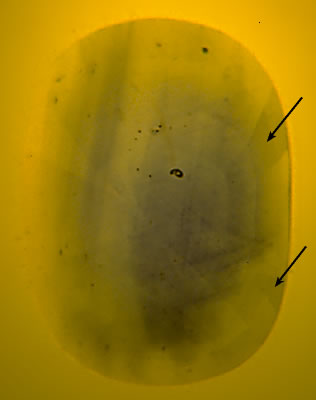In 1991, titanium-diffused blue sapphires reappeared in the Bangkok market after an absence of many years. Touted as "deep diffusion," the stones proved to have no greater color penetration than the original Union Carbide product.
Pssst. pssst. Want a hot tip? Hit the library and dredge up a gem treatment, preferably one developed years ago, so that most have forgotten it. Spice it up a bit, give it a jazzier name. Then throw a piece into a parcel of naturals and take it round to a lab on… say… New Year's Eve. Did the lab muff the identification? Great! Call in the trade media to roll out the product (and don't forget to show them the natural report). Now promote the bejesus out of it by telling people that it's virtually unidentifiable.
Sound crazy? It shouldn't. It should sound familiar, like deep surface diffusion.
Most in the gem trade have now heard of the deep surface diffusion-treated sapphires [now termed 'bulk' or 'lattice' diffusion]. But few know how to spot them. And fewer still realize that surface diffusion is nothing new. But good treatments are a bit like vampires. No matter how often you kill them they always come back to haunt you.
Surface diffusion 101
The surface diffusion treatment was first developed at Union Carbide's Linde division in the US. Linde, the first company to synthesize star corundum, had problems obtaining both uniform color and uniform silk in the same stone. Here's the recipe for cooking sapphires the Linde way:
- Pack stones in a crucible filled with the kind of chemicals which produce both rutile silk (Ti) and color (Ti, Fe, Cr, etc.).
- Heat to near the melting point (1800–1900° C) for several days or even weeks. Periodically recharge the crucible with chemicals.
- After cooling, lightly repolish, and voila – the gems now have color and/or stars.
How does it work? Like this: when a stone is heated to near the melting point, the crystal lattice is expanded to the maximum. Heat it too much and the bonds break completely. That's melting (and that's tough titty if it's your stone). But if you heat it to just below the melting point, where the bonds stretch but do not break, the gem will absorb the chemicals, creating color, asterism or both. However, atoms of Fe, Ti and Cr are fairly large and so cannot move easily into the stone. Thus the color and asterism are confined to a thin layer (0.10 to 0.50 mm) near the surface. This process was patented by Union Carbide in 1975–1977 and is termed surface diffusion [this term has been depreciated and the treatment today is properly termed 'lattice' or 'bulk' diffusion].
Surface diffusion works best on stones which have little or no color of their own, as it makes little sense to add color to something that already has plenty. The starting material is generally near-colorless sapphire from Sri Lanka. Due to the shallow penetration of surface-diffused color, stones must be cut (but facets left unpolished). After treatment the surfaces will be pockmarked from the high temperatures. And so the stones are lightly repolished (with the emphasis on lightly), to leave intact as much of the color layer as possible. Too heavy a hand on the polishing wheel results in both loss of color and $$$$.
Both faceted and star sapphires of blue and orange colors treated in this way first appeared in the gem trade in the late 1970s and early 1980s. Initially the stones were produced by the Swiss company Golay Buchel, which bought the process from Union Carbide. Later, stones treated in Thailand and elsewhere appeared. But they soon disappeared when gemologists became familiar with their characteristics. And by the mid 1980s they were rare indeed.
Return of the diffusion zombie
In mid-1988, I again began to see surface-diffusion treated corundums, or SDTCs, in Bangkok, but this time with a more sinister glint. It had always been in the back of my mind that, rather than taking near-colorless sapphires and treating them to a deep blue, some day treaters were going to take a stone which already had a lot of color of its own and just give it, via surface diffusion, a bit more. This is what happened in mid-1988 – to such an extent that I reported the matter to the International Colored Stone Association.
Treaters were taking medium-quality Kanchanaburi sapphires that had a lot of color of their own, but were heavily zoned, and diffusing their problems away.
Because certain burners were disappointed that their best efforts could still be identified, they embarked upon a campaign of threat and innuendo against Bangkok gemologists. But this had little effect, eventually giving way to…
The deep diffusion mutant • Kill it before it mates
Beginning in mid-1989, I heard about deep surface diffusion treated corundums, or D-SDTCs. Yes, that's right – deeeeep surface diffusion-treated blues. In April, 1990, after learning who was involved, I approached the principals (Las Vegas-based Gem Source) for more info. They were generous in offering both samples for study and information about their marketing plans. They planned, and have, sold the material for what it is – surface-diffusion treated corundum.
But all was not well in the Land of Blue. Jeffery Bergman of Gem Source told me in June 1991 that he had received more than ten death threats, presumably coming from paranoid Bangkok dealers who feared that the D-SDTCs would wreak havoc on the natural sapphire market. Bad craziness indeed, but it couldn't help but bring a smile to my face – the very idea that something might destroy the natural blue sapphire market. "What market?" thought I, "there are practically no natural blue sapphires being traded in 1991."
Deep diffusion– total oneness (or just TV evangelism)?
Do deep surface-diffusion treated sapphires (DSDTCs) represent gem treatment nirvana? Or are they just the Disneyland representation of the place? The original Linde patents claimed a maximum penetration of 0.50 mm, while the deepest penetration measured on the D-SDTCs is 0.40 mm. In all other respects they resemble the Linde material. So, gentle readers, this is what I say: "No way, Ray!"
But this does beg the question of why deep diffusion has created such a furor in Bangkok when the earlier activities by Thai burners raised not even a ripple. Good question. Mighty good question. It just may have something to do with the fact that the profit from the earlier doings went to local traders, while those of today go to heathens from out of town. Or maybe (and hopefully) people have finally realized that the gem-treatment genie, once out of the bottle, is a bit difficult to contain.
Stamp collecting
Let's change the subject. To stamps. Yes indeed, the little sticky things one affixes to envelopes. Daydream for just a moment…
…Here's your nightmare. A postage stamp was produced in Burundi in 1945 and is considered the world's most valuable collectors' stamp, primarily because of a printing error. It seems that the dot on the "i" in Burundi was forgotten in one batch. And before the error was caught, a few went out. So this is the world's rarest postage stamp. Now you, being the clever type that you are, get hold of some of the regular stamps and carefully erase the dot on the i. Then you sell them as the very rare type. But horror of horrors, your customers call in the police. As the police take you away shrieking and babbling you protest: "Why me? I didn't add anything. Furs are treated, fruit is treated, everything is treated nowadays." But the cops do not listen. Instead you are thrown in some hell hole of a jail with inmates whose only retort is "Why you? Why you ? Ha ha ha ha hee hee ha ha ha……… bend over."
 A D-SDTC preform which has been cut open to reveal the depth of the color layer. (Photo: Wimon Manorotkul)
A D-SDTC preform which has been cut open to reveal the depth of the color layer. (Photo: Wimon Manorotkul)
Distracted to distraction
Today it is with sickening regularity that when a new gem treatment is introduced to the trade, attention is immediately focussed on its stability, rather than on the fact that the stone is treated. "Boys will be boys, dear" is the effective refrain. And while the police argue over whether the "boys" shot her with a gun or stabbed her with a knife the victim bleeds to death. Of course, we do have to play our part in this little charade, don't we? Because the fact of the matter is that precious few of the precious stones we trade today started out that way. I'm Chicken Little. And yes, the sky is falling. It's coming down all around me.

|
Identifying Surface Diffusion Treated Corundums In other fields, ignorance may be bliss; in the gem trade it is far from it. Identification of surface diffusion treated corundums (SDTCs) and so-called deep surface-diffusion treated corundums (D-SDTCs) is usually a straightforward process, but be careful. There are traps for the unwary. Identification centers around one simple fact: in nature a crystal grows in the ground; that crystal bears only a superficial relationship to the shape of the cut gem. Color in natural single crystals forms in bands or zones parallel to crystal faces, not along polished facets, because the stone was not faceted when it was growing in the ground. Despite the irrefutable nature of that last statement, some have attempted to hoodwink people into believing otherwise. They say that the stone just received "surface heat." Surface heat? In a crucible at 1900° C? And does the Pillsbury Dough Boy pop out of the oven to tell 'em when the stones are done, too?
Proper setup and use of the microscope is vital to the identification. The stone should be immersed in pure methylene iodide (RI = approximately 1.735) and viewed under magnification with a white (frosted) plastic or glass plate covering the light source (diffuse light-field illumination). Under these conditions, reflections from the corundum's external surfaces are eliminated. This allows the stone's interior to be seen with no distortion from the reflection and refraction of light off internal and external surfaces. Thus the true distribution of color is revealed. Possible errors in identificationAs mentioned earlier, identification of SDTCs is not something to be approached lightly – it can be tough! The first requirement is to get your hands on some of those 100 percent positive SDTCs. Some, rather than one, if possible. Then these can be used to make side-by-side comparisons with unknown stones. One further thing. Any lab in business today can make mistakes. Always remember that. In November of 1988, the Asian Institute of Gemological Sciences laboratory in Bangkok misidentified a heat treated blue sapphire as being surface-diffusion treated. This occurred because the gemologists saw a dark reflection on the girdle (the girdle was quite thick) and misinterpreted it as the color concentration from a surface-diffusion treatment. So always remember – people test your stones, not automatons. Gemologists are people, and they do make mistakes, even those who frequent ivory towers. |
|
Surface-Diffusion Treated Corundums
Varieties: anything, usually blue; rarely orange, red, star The color of SDTCs will follow the facet pattern of the stone exactly. Some facets may be lighter or darker than others, but the color exactly follows the facet pattern of the cut stone. Certain facets may have most or all of their color removed by repolishing. Stones may contain substantial internal color, in addition to the thin surface-diffusion color layer just beneath the surface. Color is concentrated in a layer at the surface some 0.10–0.50 mm deep (or less). When immersed table down in methylene iodide, this tends to give these stones a darker girdle (unless cutters have tried to avoid detection by heavily repolishing the girdle itself and the girdle facets). Be careful not to confuse the reflections from a thick girdle with the surface color concentrations of a true SDTC. Facet junctions, girdles, culets and other edges will show color concentrations under immersion. This is because color penetration is greater at edges when compared to the center of facets. Pits, cracks, cavities, feathers and fingerprints will show a bleeding of color into them. The reason for the bleeding of color is that the cracks offer a ready means for the entry of the coloring agent, but are not touched during the repolishing process. In addition to the above, you may see any of the features normally associated with heat treated corundums, because the SDTCs are a subset of heat treated corundums. Note: All of the above features are seen best under immersion with diffused light-field illumination. |
|
AGTA sets disclosure terms for diffusion treated stones [from 1992] The American Gem Trade Association (AGTA) recently adopted a resolution to determine the disclosure terminology which must be used by AGTA members in the sale of diffusion treated gemstones. The resolution, as outlined by the AGTA board of directors, reads as follows:
This disclosure language must be printed in a type size and location so as to be conspicuous, according to the AGTA resolution. The AGTA adds that it is not acceptable to use the words "heat treated" or "natural" in advertising and selling diffusion treated gemstones as the above descriptive terms may confuse consumers to believe that the stones defined with such wording are naturally colored and/or heat treated natural gemstones. "While use of the disclosure language adopted by AGTA is mandatory only to AGTA members, AGTA encourages nonmembers to use the above disclosure terminology as well," says Owen Bordelon, AGTA board member. "AGTA feels the terminology is accurate, communicative, and leaves nothing to question." Roland Naftule, chairman of AGTA's Industry Rules Committee, adds: "AGTA is confident that the Federal Trade Commission (FTC) will support our efforts regarding accurate disclosure terminology for diffusion-treated sapphire." |
About the author
Richard W. Hughes is one of the world’s foremost experts on ruby and sapphire. The author of several books and over 170 articles, his writings and photographs have appeared in a diverse range of publications, and he has received numerous industry awards. Co-winner of the 2004 Edward J. Gübelin Most Valuable Article Award from Gems & Gemology magazine, the following year he was awarded a Richard T. Liddicoat Journalism Award from the American Gem Society. In 2010, he received the Antonio C. Bonanno Award for Excellence in Gemology from the Accredited Gemologists Association. The Association Française de Gemmologie (AFG) in 2013 named Richard as one of the fifty most important figures that have shaped the history of gems since antiquity. In 2016, Richard was awarded a visiting professorship at Shanghai's Tongji University. 2017 saw the publication of Richard's Ruby & Sapphire: A Gemologist's Guide, arguably the most complete book ever published on a single gem species and the culmination of nearly four decades of work in gemology.
Afterword
This article was first published in JewelSiam (1992, No. 3, May–June, pp. 83–86). Today the proper gemological nomenclature for such stones is "bulk diffusion." For more on this subject, see also:
- The Skin Game by Richard W. Hughes
- There's a Rumble in the Jungle: The Sapphire Face-Lift Face-Off Saga by Richard W. Hughes



